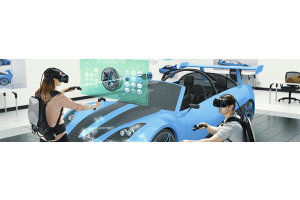We use cookies to offer you a better experience. For more information on how we use cookies you can read our Cookie and Privacy Policy.
SSD vs HDD: Which Hard Drive Do I Need?
November 16, 2018

If you’re in the market for a new laptop or PC, you’re probably filtering your way through a tall stack of features, including everything from screen size and resolution to storage space and memory. You’ll likely prioritize which specs fall on your must-have list, and which bells and whistles might be nice to have, depending on your computing needs and budget.
When it comes down to making a decision on your next laptop or PC, arguably the most important feature to consider is the type of hard drive it comes equipped with. Not sure about the difference between a solid state drive (SSD) versus a hard drive disk (HDD)? You should take time to educate yourself. It could make or break the performance of your new computer.
Read on to learn more about the different types of hard drives and why they matter, so you can confidently move forward with your new investment.
What is a hard drive?
Essentially, the hard drive is where everything on your computer is stored, organized in metaphorical filing cabinets, ready to be retrieved and processed by the central processing unit (CPU).
We use the term “hard,” meaning the drive is a physical, tangible component of your laptop or desktop PC, as opposed to software that can be installed post-purchase.
Although it’s possible to swap out your hard drive, customizing your setup as your computing needs evolve, it’s usually much more convenient and economical to start off with a hard drive ready to solve all your potential demands.
What does a hard drive do?
A hard drive stores much more than your school essays, business documents, Adobe Photoshop masterpieces, and triple-A (AAA) game titles.
It also stores all the code required by your operating system (OS), the drivers for your accessories, the framework for internet connection, and more.
Your PC will come stock with a specified amount of hard drive space, which is pre-filled with a certain amount of data, usually 10GB to 20GB depending on your OS, that enables your computer to function.
The rest of the space is yours to fill as you see fit. Download songs, install software, save as many cat photos as you like. The choice is yours.
The larger the hard drive, the more storage capacity you have to play with, but storage space isn’t always indicative of a computer’s quality.
Types of hard drives
Although all hard drives are tasked with data storage, they’re not all built the same.
Before delving into the difference between a solid state drive and a hard disk drive, lets first review the computer’s bus architecture.
A bus is a common pathway through which information flows from one computer component to another [1]. Think of the bus as a conduit that works via cable, printed circuit, etc., that relays information between hardware and software components within your computer, allowing your computer to communicate between internal systems.
Traditional HDDs typically depend on a type of bus called a Serial Advanced Technology Attachment (SATA). The SATA uses serial signaling technology to transfer data from your hard drive to the rest of your computer systems.
Note: The SATA is technically the interface between the HDD and your computer’s motherboard, but it does not refer to the hard drive itself. Often, however, the terms are used interchangeably.
Like neurons firing between synapses in the brain, a SATA hard drive provides a connection to the rest of the computer, transferring information as a series of signals by which code is received, processed, and executed by the CPU.
An HDD relies on a spinning magnetic disk to read and write data with a mechanical arm (somewhat similar to a record player) in order to communicate and store information.
A solid state hard drive (SSD), which lacks any moving parts, works a bit differently. Instead of a disk and SATA bus, SSDs uses an embedded processor called a controller to read and write data onto interconnected flash memory chips.
They lack the electricity requirement necessary to spin a hard drive disk, so the memory chips retain their data even when no power is present.
When focusing on a computer’s external features, such as screen size, keyboard lighting, or the aluminum finish, it can be easy to overlook its internal components, especially if you don’t understand what your hard drive can offer.
What are the differences between SSD and HDD?
The main difference between a solid state drive and a hard disk drive is that data is stored on either a small, flash memory chip or a large, spinning memory disk, but this difference plays out across a number of variables.
SSD vs. HDD storage capacity
Solid state drives are advantageous because the memory microchips are much smaller and more compact than large hard drive disks.
As technology advances, data becomes more compressed and SSDs continue to shrink in size, allowing laptops to become thinner, lighter, and easier to transport.
However, while an SSD might be smaller than an HDD, that also means they could be limited in their storage capacity. HDDs offer massive amounts of storage space, making them a leading choice for large-scale servers.
How much storage do you need? Most average users would be fine with 250 to 300 gigabytes (GB). To put it in perspective, you could store about 30,000 average-sized photos or songs with 250GB.
If you plan to download movies or triple-A (AAA) games, you might want to upgrade to a hard drive with 500GB or even 1TB.
That being said, as cloud-based storage alternatives continue to expand and more software converts to online web applications, less importance is placed on internal memory space.
SSD vs. HDD processing speed
HDD/SATA drives come in a number of different speeds, which affects how quickly your data is relayed. This gives you the flexibility to choose as much or as little processing power you need.
SSD controllers also vary in speed, but they’re almost always faster than HDDs since they use flash memory and do not depend on a mechanical arm to physically read and write data.
Boot up times are significantly quicker for SSDs as well, requiring only about 10 seconds, whereas SATA drives could take up to 30 seconds or more.
Even on lower-end SDD models, the time it takes to open files is much less than an HDD due to the high-speed, interconnected flash memory chips.
SSD vs. HDD application performance
Because SSD PCs read files much faster, they’ll run your applications more smoothly and reliably. This is especially true for multi-media users who frequently rely on video editing or digital design software that requires rapid rendering.
According to PC Mag, SSDs boot faster, launch and run apps faster, and transfer files faster [2]. Whether you're using your computer for fun, school, or business, the extra speed may be the difference between finishing on time and failing.
If you’re running an intense workload and need your computer to execute tasks without a hitch, you probably don’t want to be hobbled by a mechanical hard drive disk and should opt for an SDD.
Those with a short queue depth and greater need for storage will likely be fine operating on an HDD.
SSD vs. HDD gaming experience
SSDs cut down on boot times and load large files faster, but you won’t notice much of an in-game difference between that and an HDD.
Your gaming experience is more dependent on your graphics card and random access memory (RAM), which differs from your hard drive memory in that it’s stored only temporarily, not permanently.
It’s worth mentioning that HDDs are susceptible to fragmentation, and frequent gaming can increase your risk of a fragmented disk.
Fragmentation refers to little bits of data spread out across the memory disk. It’s almost like tearing up tiny pieces of paper and tossing them into the wind, attempting to sort them and then decipher the distorted message.
It forces your computer to work harder to read a single file than it would if the data had loaded in a long, continuous line which will definitely cause it to be slower. A fragmented hard drive can also lead to random crashes or freezes, among a slew of other problems, affecting not only your gaming but your overall PC performance.
SSD vs. HDD energy consumption
SSDs use up to one-half to one-third less power than HDDs do (usually 2 to 3 watts versus 6 to 7 watts). If you’re running multiple HDD workstations in an office space, this is a difference you’d definitely notice on an electricity bill.
Comparing different laptop hard drives, an SSD battery will last two to three times longer than a laptop using a SATA interface would.
When energy-efficiency is at the top of your priority list, a solid state drive is usually the better choice.
SSD vs. HDD durability
HDDs use spinning disks to read and write data, so they perform better in stationary locations where the moving parts are less vulnerable to jostling.
The nature of a solid state drive is less fragile and more likely to protect your data from shock damage in the event of an accidental drop.
Those who are prone to unexpected tumbles should opt for a more durable SSD It lacks the delicately moving parts that could potentially be bumped askew.
Pros and cons of an SSD over an HDD
To sum it up, an HDD/SATA drive shines in terms of storage capacity. It’s also more approachable in price, costing on average 80% less per GB than the cost of an SSD drive [3].
That said, solid state drives may be worth the price jump depending on your budget and computing needs. They’re usually much more reliable in terms of speed, performance, energy efficiency, and durability.
As an added note, a laptop or desktop PC with a hard SATA drive is much noisier due to the constantly whirring, spinning disk, which also emits more heat than an SSD, meaning fans will be running more often as well.
HDDs offer massive amounts of memory space, but the extra storage capacity typically comes with added weight. Comfort, convenience, and price are all factors worth considering when selecting an SSD vs. HDD.
Bottom line: SSD or HDD?
The HDD has been around for some 60 to 80 years. Almost a decade ago in 2008, SATA hard disks reached near market saturation and were utilized as the standard in as much as 99 percent of drives [4].
Today, SSDs have taken a great deal of the market share due to their superior performance, even despite the uptick in price.
SATA drives still have their purpose, though. They allow you to store massive amounts of information relatively inexpensively. It’s not uncommon to use a SATA interface to expand memory and store data such as pictures, documents, and music libraries while the actual OS is stored on an SSD.
It all comes down to understanding your storage needs, speed requirements, and how you intend to use your computer. Balancing out these different factors will help you find the right hard drive solution.
Whether you choose a traditional SATA hard disk drive or opt for a newer solid state drive, keep in mind that they’re both capable of failure. It’s critical to take the time to back up your hard drive using an external device, cloud-based service, or alternative means.
Now that you know the key differences between the different types of hard drives, you should feel less stressed and more confident in your next computer purchase. With the right backup and security measures in place, you’ll be able to enjoy your investment for years on end.
[1] TurboFuture; Type of Buses in Computer Architecture
[2] PC Mag; SSD vs HDD: What’s the Difference?
[3] Computer Direct Outlet; SSD vs. SATA HDD - How to Choose the Best Hard Drive
[4] Serial ATA; Meeting Storage Needs Today and Tomorrow
About the Author: Kaelee Nelson is a contributing writer for HP® Tech Takes. Kaelee is an experienced writer based in Southern California and specializes in creating informative content related to technology and digital culture.
Article reposted with permission from HP Tech Takes






